Transcription of Rehabilitation Guidelines for Patellar ORIF
1 4 Northwest Ohio Orthopedics and Sports Medicine 7595 County Road 236, Findlay, OH 45840 Phone: Fax: NWO Therapy Department Rehabilitation Guidelines for Patellar ORIF The intent of this protocol is to provide the clinician with a guideline to establish and progress a patient through post operative Rehabilitation . It is not intended to be a substitute for one s clinical decision making. The plan of care should be based upon the patients clinical exam and individual goals. Prior to initiation of interventions the therapist needs to check with the surgeon/ operative report regarding progression. The therapist needs to take into consideration multiple variables including: mechanism of injury, fracture type, fixation method, fixation stability, bone and tissue quality, patient characteristics including comorbidities, age, goals, and expectations, and surgeon specific philosophy/preferences.
2 Based upon these variables, wide variations of progressions and patient outcomes may exist, however the following is a basic guideline that can be used to reference. Notify the surgeon immediately of any concerns for DVT, infection, excessive edema, or significant variation in expected progression/outcomes Pre-Op (if available) Measure for and fit for post operative brace (double upright, locked at 0) Measure for and fit with ted hose Perform crutch/walker training and issue crutches/walker if needed Evaluation should be scheduled for 2- 3 days after surgery post -op instructions and education from surgery date to initial physical therapy appointment Phase I: 0-6 week Goals: Maintain integrity of repair Decrease pain and inflammation Promote tissue and fracture healing Achieve/maintain full extension Incrementally increase passive range of motion (per surgeon consultation) Facilitate quadriceps contraction Patient education of precautions and progressions Precautions.
3 No quick movements No aggressive stretching Avoid PROM that is too aggressive or provokes muscle guarding 4 Northwest Ohio Orthopedics and Sports Medicine 7595 County Road 236, Findlay, OH 45840 Phone: Fax: NWO Therapy Department Keep incision dry and clean Ensure proper brace fit/locked in extension 0- 2 weeks PROM 0 extension o Must achieve 0 extension o No flexion Patella mobilizations May initiate quadriceps isometrics (relative pain free) Brace locked at 0 and PWB o Note: if painful/swollen may keep PWB for 2 additional weeks (or per physician recommendation) 2- 4 weeks Maintain 0 degrees extension. ROM flexion to 30 degrees NMES to fascilitate quad contraction if indicated Ambulation with brace locked at 0 and WBAT 4- 6 weeks Advance flexion ROM to 60 degrees (or per physician recommendation) Continue with current exercises and activities Phase II: 6-12 weeks Criteria to progress to phase II.
4 Achieve bone healing by adhering to precautions in phase I o Check with surgeon Staged ROM goals achieved (per consultation with surgeon) Minimal pain/effusion Goals for Phase II Continue healing of fracture site Do not overstress healing structures Restore full PROM by week 12 Normalize AROM Initiate gradual return to functional activities and light work activities o Note: progression is time and criterion based and needs to progress per continuous assessment of patients impairments and functional limitation 6- 12 weeks Initiate functional weightbearing exercises Initiate open kinetic chain AROM Initiate isotonic strengthening exercises Initiate balance/proprioception exercises 4 Northwest Ohio Orthopedics and Sports Medicine 7595 County Road 236, Findlay, OH 45840 Phone: Fax: NWO Therapy Department Advance intensity of PROM Unlock brace with ambulation, once displays functional quadriceps control may switch to functional short hinge knee brace.
5 Phase III: 12+ weeks Criteria to progress to phase III Minimal pain with AROM and strengthening activities Full AROM without substitution 5/5 strength without substitution Goals Full Passive/AROM Enhance dynamic stability Gradual restoration of strength, power, and endurance Advance neuromuscular control Return to full ADLs/work o 12+ weeks: Advance all activities based upon patient goals and expectations. Each patient is an individual and should be treated as such. Work together with the referring orthopedic for optimal patient outcome. References: Kinner D, Nathwani D. Traumatic problems of the patella. Orthopedics and Trauma 2012; 26 (5): 354-361. Mehling I, Mehling A, Rommens P. Comminuted Patellar fractures. Current Orthopaedics 2006; 20: 397-404. Della Rocca G. Displaced patella fractures. J Knee Surg 2013; 26: 293-300. Axe M, Snyder-Mackler L. Postoperative Management of Orthopaedic Surgeries: Independent Study Course ; 2005.
6 Ciriello V, Gudipati S, Tosounidis T, Soucacos PN, Giannoudis PV. Clinical outcomes after repair of quadriceps tendon rupture: a systematic review. Injury 2012; 43 (11): 1931-1938. 4 Northwest Ohio Orthopedics and Sports Medicine 7595 County Road 236, Findlay, OH 45840 Phone: Fax: NWO Therapy Department Lee D, Stinner D, Miller H. Quadriceps and Patellar Tendon Ruptures. J Knee Surg 2013; 26: 301-308. Axe M, Snyder-Mackler L. Postoperative Management of Orthopaedic Surgeries: Independent Study Course ; 2005. West J, Keene J, Kaplan L. Early motion after quadriceps and Patellar tendon repairs: outcomes with single-suture augmentation. Am J Sports Med 2008; 36 (2): 316-323.

